The Blood Culture Test Market is estimated to be valued at USD 5.3 billion in 2025 and is projected to reach USD 8.6 billion by 2035, registering a compound annual growth rate (CAGR) of 4.9% over the forecast period.
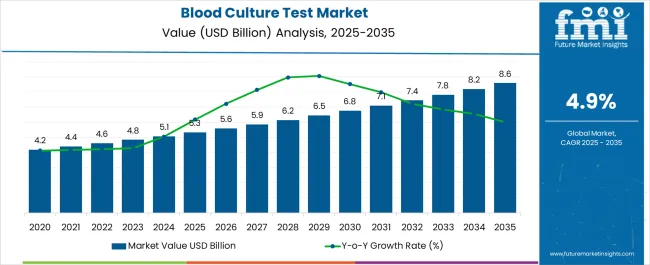
| Metric | Value |
|---|---|
| Blood Culture Test Market Estimated Value in (2025 E) | USD 5.3 billion |
| Blood Culture Test Market Forecast Value in (2035 F) | USD 8.6 billion |
| Forecast CAGR (2025 to 2035) | 4.9% |
The blood culture test market is witnessing steady growth, supported by rising prevalence of bloodstream infections and increasing demand for early and accurate diagnostic methods. Heightened focus on sepsis detection and the need for timely treatment interventions are driving greater adoption of advanced testing solutions. Hospitals and diagnostic laboratories are investing in automated systems and high-sensitivity consumables to improve workflow efficiency and reduce diagnostic turnaround times.
Regulatory agencies and healthcare bodies are emphasizing the importance of early pathogen detection to lower mortality rates and optimize antibiotic stewardship programs. Continuous advancements in culture-based technologies and the integration of molecular diagnostics are expanding the market’s capabilities in detecting a broader spectrum of pathogens.
Growing healthcare expenditure, coupled with rising awareness of hospital-acquired infections, is further shaping adoption trends across both developed and emerging economies With healthcare systems prioritizing patient outcomes and cost-effective diagnostic practices, the market is positioned for long-term expansion, supported by innovation in consumables, automation platforms, and infection management protocols.
The blood culture test market is segmented by product, technology, application, end-user, and geographic regions. By product, blood culture test market is divided into Consumables, Instruments, and Software and Services. In terms of technology, blood culture test market is classified into Culture-based Technology, Molecular Technology, Microarray, PCR, PNA-FISH, Proteomic Technology, and Others. Based on application, blood culture test market is segmented into Bacterial Infections, Fungal Infections, and Mycobacterial Infections. By end-user, blood culture test market is segmented into Hospital Laboratories, Reference Laboratories, Research Laboratories, and Others. Regionally, the blood culture test industry is classified into North America, Latin America, Western Europe, Eastern Europe, Balkan & Baltic Countries, Russia & Belarus, Central Asia, East Asia, South Asia & Pacific, and the Middle East & Africa.
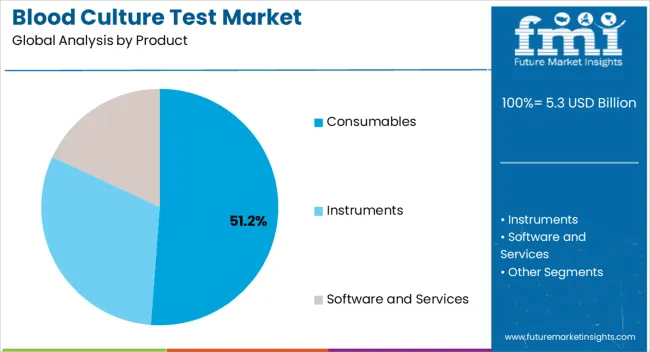
The consumables segment is projected to account for 51.2% of the blood culture test market revenue share in 2025, establishing it as the dominant product category. This leadership is being reinforced by the recurring demand for media, reagents, and specialized kits required in routine diagnostic testing. High utilization rates of consumables in hospitals, diagnostic laboratories, and research institutions ensure steady market growth, as these items are critical for every culture procedure performed.
The rising incidence of bloodstream infections and increasing awareness of early diagnostic practices are contributing to elevated testing volumes, directly driving demand for consumables. Continuous improvements in formulation and packaging are enhancing contamination resistance and test accuracy, further supporting their widespread adoption.
Manufacturers are investing in developing consumables compatible with automated systems, enabling faster processing and standardized results The segment’s recurring revenue model and indispensability in diagnostic workflows are securing its leadership position, with growth expected to continue as infection detection remains a top priority across healthcare systems globally.
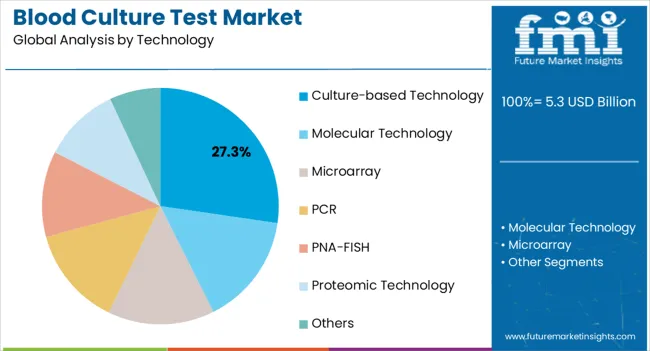
The culture-based technology segment is anticipated to hold 27.3% of the blood culture test market revenue share in 2025, making it a leading technological approach. Its dominance is being supported by its established reliability in detecting a wide range of pathogens and its continued use as a gold standard in clinical microbiology. Despite advancements in molecular diagnostics, culture-based methods remain critical due to their ability to provide viable organisms for antimicrobial susceptibility testing, which guides effective treatment decisions.
The affordability and widespread availability of culture-based systems are reinforcing adoption, especially in developing economies where cost efficiency is vital. Advancements in automated culture systems have reduced time to detection, improving clinical outcomes by enabling earlier therapeutic interventions.
Hospitals and laboratories are continuing to rely on culture-based techniques because of their regulatory acceptance and proven diagnostic accuracy The segment’s balance of cost-effectiveness, diagnostic precision, and compatibility with downstream testing workflows ensures that culture-based technologies will maintain a central role in the market.
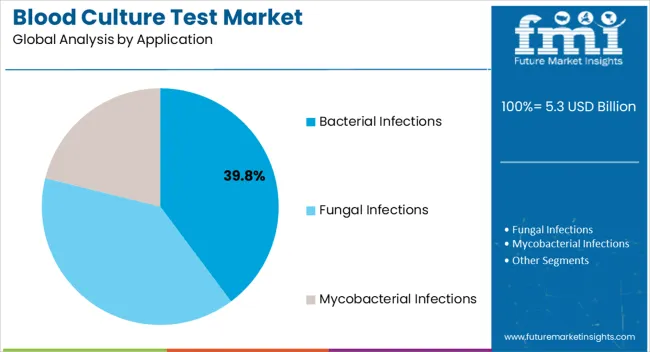
The bacterial infections segment is expected to capture 39.8% of the blood culture test market revenue share in 2025, making it the leading application area. Its prominence is being driven by the high global burden of bacterial bloodstream infections, which require prompt and accurate identification for effective treatment. Hospitals and diagnostic centers are prioritizing bacterial infection testing to reduce sepsis-related complications and improve patient survival rates.
The rise in antimicrobial resistance is also fueling demand for accurate diagnostic tools that support targeted antibiotic use and stewardship programs. Increased hospital admissions, especially among aging populations and immunocompromised patients, are further driving the need for reliable bacterial infection testing.
Continuous improvements in culture media and detection methods are enhancing test sensitivity, ensuring faster results without compromising accuracy As bacterial infections remain the most common cause of bloodstream-related illnesses worldwide, the segment’s dominant share is expected to persist, with sustained demand from both developed and emerging healthcare markets.
A major factor driving the demand for blood culture tests is the increasing incidence of sepsis and other blood-related clinical conditions. Expanding opportunities for the blood culture tests market will be brought by the higher approval rate of new products such as consumables and instruments for diagnosing Bloodstream Infections (BSI). Furthermore, Bloodstream Infections is a global concern and many people affected with this disorder will further need blood culture tests for identification will increase market expansion in the forecasted period.
The growing aging population and advancement in medical technologies, government awareness resulting in the rising government initiatives, and awareness among people in developed as well as developing countries all are factors that will boost the market expansion of the blood culture tests market.
The established economy of North America is anticipated to drive demand for blood culture tests, followed by Europe and the Asian region. In North America technically advanced healthcare infrastructure, high patient awareness, and significant healthcare spending all are contributing factors to market expansion in this region. Furthermore, advanced Medtech techniques like electro-spray ionization and Bac Spectrum assay increase the growth of the market.
Furthermore, rising disease incidences, favorable government initiatives, and investment in research and development regions are expected to experience rapid growth in the blood culture test market in the European regions. Moreover, Latin America and the East and South Asia regions are likely to experience sustainable growth in the forecast period due to the increasing population.
Some of the market players operating in the blood culture tests market are bioMérieux SA, Roche Diagnostics, Becton Dickinson, Siemens AG, Thermo Fisher Scientific Inc., Bruker Corporation, Cepheid, Alere Inc., Nanosphere, Danaher Corporation, and Abbott Laboratories.
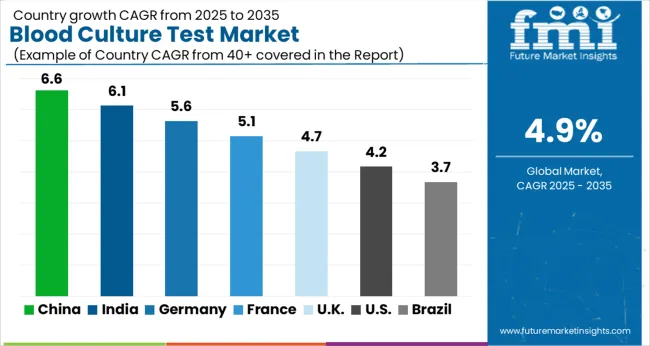
| Country | CAGR |
|---|---|
| China | 6.6% |
| India | 6.1% |
| Germany | 5.6% |
| France | 5.1% |
| UK | 4.7% |
| USA | 4.2% |
| Brazil | 3.7% |
The Blood Culture Test Market is expected to register a CAGR of 4.9% during the forecast period, exhibiting varied country level momentum. China leads with the highest CAGR of 6.6%, followed by India at 6.1%. Developed markets such as Germany, France, and the UK continue to expand steadily, while the USA is likely to grow at consistent rates. Brazil posts the lowest CAGR at 3.7%, yet still underscores a broadly positive trajectory for the global Blood Culture Test Market. In 2024, Germany held a dominant revenue in the Western Europe market and is expected to grow with a CAGR of 5.6%. The USA Blood Culture Test Market is estimated to be valued at USD 1.8 billion in 2025 and is anticipated to reach a valuation of USD 2.8 billion by 2035. Sales are projected to rise at a CAGR of 4.2% over the forecast period between 2025 and 2035. While Japan and South Korea markets are estimated to be valued at USD 273.8 million and USD 180.9 million respectively in 2025.
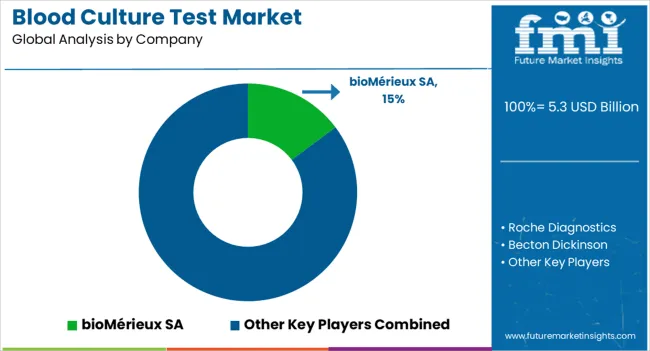
| Item | Value |
|---|---|
| Quantitative Units | USD 5.3 Billion |
| Product | Consumables, Instruments, and Software and Services |
| Technology | Culture-based Technology, Molecular Technology, Microarray, PCR, PNA-FISH, Proteomic Technology, and Others |
| Application | Bacterial Infections, Fungal Infections, and Mycobacterial Infections |
| End-User | Hospital Laboratories, Reference Laboratories, Research Laboratories, and Others |
| Regions Covered | North America, Europe, Asia-Pacific, Latin America, Middle East & Africa |
| Country Covered | United States, Canada, Germany, France, United Kingdom, China, Japan, India, Brazil, South Africa |
| Key Companies Profiled | bioMérieux SA, Roche Diagnostics, Becton Dickinson, Siemens AG, Thermo Fisher Scientific Inc., Bruker Corporation, Cepheid, Alere Inc., Nanosphere, Danaher Corporation, and Abbott Laboratories |
The global blood culture test market is estimated to be valued at USD 5.3 billion in 2025.
The market size for the blood culture test market is projected to reach USD 8.6 billion by 2035.
The blood culture test market is expected to grow at a 4.9% CAGR between 2025 and 2035.
The key product types in blood culture test market are consumables, instruments and software and services.
In terms of technology, culture-based technology segment to command 27.3% share in the blood culture test market in 2025.






Our Research Products

The "Full Research Suite" delivers actionable market intel, deep dives on markets or technologies, so clients act faster, cut risk, and unlock growth.

The Leaderboard benchmarks and ranks top vendors, classifying them as Established Leaders, Leading Challengers, or Disruptors & Challengers.

Locates where complements amplify value and substitutes erode it, forecasting net impact by horizon

We deliver granular, decision-grade intel: market sizing, 5-year forecasts, pricing, adoption, usage, revenue, and operational KPIs—plus competitor tracking, regulation, and value chains—across 60 countries broadly.

Spot the shifts before they hit your P&L. We track inflection points, adoption curves, pricing moves, and ecosystem plays to show where demand is heading, why it is changing, and what to do next across high-growth markets and disruptive tech

Real-time reads of user behavior. We track shifting priorities, perceptions of today’s and next-gen services, and provider experience, then pace how fast tech moves from trial to adoption, blending buyer, consumer, and channel inputs with social signals (#WhySwitch, #UX).

Partner with our analyst team to build a custom report designed around your business priorities. From analysing market trends to assessing competitors or crafting bespoke datasets, we tailor insights to your needs.
Supplier Intelligence
Discovery & Profiling
Capacity & Footprint
Performance & Risk
Compliance & Governance
Commercial Readiness
Who Supplies Whom
Scorecards & Shortlists
Playbooks & Docs
Category Intelligence
Definition & Scope
Demand & Use Cases
Cost Drivers
Market Structure
Supply Chain Map
Trade & Policy
Operating Norms
Deliverables
Buyer Intelligence
Account Basics
Spend & Scope
Procurement Model
Vendor Requirements
Terms & Policies
Entry Strategy
Pain Points & Triggers
Outputs
Pricing Analysis
Benchmarks
Trends
Should-Cost
Indexation
Landed Cost
Commercial Terms
Deliverables
Brand Analysis
Positioning & Value Prop
Share & Presence
Customer Evidence
Go-to-Market
Digital & Reputation
Compliance & Trust
KPIs & Gaps
Outputs
Full Research Suite comprises of:
Market outlook & trends analysis
Interviews & case studies
Strategic recommendations
Vendor profiles & capabilities analysis
5-year forecasts
8 regions and 60+ country-level data splits
Market segment data splits
12 months of continuous data updates
DELIVERED AS:
PDF EXCEL ONLINE
Blood Testing Equipment Market Growth - Trends & Forecast 2025 to 2035
Blood Sugar Tester Market Size and Share Forecast Outlook 2025 to 2035
Blood Ketone Test Meter Market
Home Blood Testing Devices Market Insights - Trends, Growth & Forecast 2025 to 2035
Agriculture Testing Services Market Growth – Trends & Forecast 2018-2028
Blood Urea Nitrogen Testing Market
Oncology Blood Testing Market Size and Share Forecast Outlook 2025 to 2035
IgE Allergy Blood Tests Market Size, Growth, and Forecast 2025 to 2035
Point Of Care Blood Testing Devices Market Size and Share Forecast Outlook 2025 to 2035
Tumor-sequencing Blood Testing Market
Blood Compatible Nanocoating Market Size and Share Forecast Outlook 2025 to 2035
Blood Gas Analyzers Market Size and Share Forecast Outlook 2025 to 2035
Blood Flow Restriction Bands Market Size and Share Forecast Outlook 2025 to 2035
Test and Measurement Equipment Market Size and Share Forecast Outlook 2025 to 2035
Testosterone Test Market Size and Share Forecast Outlook 2025 to 2035
Test rig Market Size and Share Forecast Outlook 2025 to 2035
Blood-based Biomarker For Alzheimer's Disease Diagnostics Market Size and Share Forecast Outlook 2025 to 2035
Blood Bank Reagent Market Size and Share Forecast Outlook 2025 to 2035
Blood Clot Retrieval Devices Market Size and Share Forecast Outlook 2025 to 2035
Blood Glucose Monitoring Devices Market Size and Share Forecast Outlook 2025 to 2035

Thank you!
You will receive an email from our Business Development Manager. Please be sure to check your SPAM/JUNK folder too.
Chat With
MaRIA